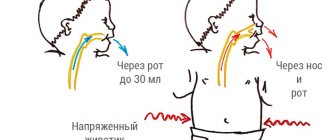What is hypoxia
Hypoxia is oxygen starvation , which develops during the prenatal period of a child. It is associated with the development of various pathological conditions that accompanied a woman during pregnancy.
Symptoms:
- Blue color of the skin.
- Cramps.
- Depression of the central nervous system.
- Breathing problems.
Hypoxia is diagnosed based on an assessment of his vital functions on the Apgar scale . If a child scores less than 7 points, this indicates hypoxia.
The consequences of hypoxia are diagnosed using ultrasound of the brain, EEG of the brain and based on an examination by specialist doctors.
The principles of treatment depend on the severity of hypoxia . Most often, it includes medications to improve brain function, massage and preventive measures (frequent walks in the fresh air, strengthening the immune system).
What does a healthy newborn look like?
After the baby's breathing returns to normal, his skin should acquire a pleasant pink tint. Expectant mothers should keep in mind that it’s not just the color of their baby’s skin that can surprise them. The surface of a newborn's skin is covered with a white coating. This substance is a lubricant that protected the baby during pregnancy. For nine months the child was in amniotic fluid. Despite the fact that it is maximally adapted to the fetal body, prolonged contact of the baby’s skin with it can lead to soaking. After birth, the baby is thoroughly dried with a soft cloth. Various “flaws” may be observed on the baby’s skin at birth and immediately after it. Even a harmless pimple can scare inexperienced parents. How to understand whether this or that skin condition is normal? What are the dangers of a rash or the appearance of birthmarks on the skin?
Causes of hypoxia
- Pathological changes in the placenta and its detachment.
- The umbilical cord is wrapped around the baby's neck . This predisposing factor can be diagnosed during a routine ultrasound. If entanglement is observed during the examination, the issue of delivery through surgery is decided.
- Diseases of the cardiovascular system in a pregnant woman. Especially often, the cause of the development of pathology is heart disease.
- Gestosis of the 2nd half of pregnancy . A dangerous phenomenon that is manifested by increased blood pressure, edema and the appearance of protein in the urine.
- High blood pressure.
- Bleeding during childbirth.
- Threat of premature birth.
- Alcohol abuse during pregnancy.
- Drug addiction.
- Taking certain medications . These include some groups of antibiotics and hormonal drugs.
- Genetic abnormalities in fetal development . For example, Down syndrome.
- Abdominal injuries.
- Diabetes mellitus in a pregnant woman.
- Diseases of the respiratory system during pregnancy.
- Acute infectious diseases suffered during pregnancy . These include influenza, measles, rubella and chickenpox. These infections often complicate pregnancy by fetal hypoxia and other pathologies.
- Intrauterine infections . These include pathogens of sexually transmitted infections and opportunistic microorganisms (Escherichia coli, Klebsiella).
- Insufficient exposure to fresh air during pregnancy. To a lesser extent influence the development of hypoxia. But nevertheless, staying in the fresh air reduces the risk of hypoxia several times.
Causes of blue skin at birth?
During childbirth, a woman may notice that the baby was born blue. If the doctors consider his condition to be satisfactory, this situation most likely will not cause concern to the mother. Still, what does a blue face mean in a newborn and can blue always be considered the norm? It is very common for babies to have this skin tone at birth. Pediatricians have developed a special scale, according to which the pediatrician present at the birth must determine the condition of the baby.
Apgar score:
Interpretation of the results:
| Total points | Decoding |
| 10/10 | The baby's indicators are above normal |
| 8/9, 9/9, 9/10 | The baby's condition is normal |
| 8/8 | The baby's performance is above average |
| 6/7, 7/8, 7/7 | The baby does not need additional supervision |
| 5/6, 5/5, 4/5, 4/4 | The baby's condition requires additional and thorough monitoring. |
| 3/3, 3/4 | The newborn is in critical condition |
| 0/0, 0/1, 1/1, ½, 2/2, 2/3 | The baby needs urgent resuscitation |
Ideally, a newborn's skin will be more purple than blue. This is due to several factors: the special structure of hemoglobin and the stress received during childbirth. The bluish tint to the skin should go away within a short period of time after birth. If this does not happen, the doctor should immediately take measures to eliminate the cause of this condition.
Video: The first minutes after birth. Inspection and processing.
Video
Pathological blue discoloration can occur in the following cases:
- chronic hypoxia;
- acute oxygen starvation;
- birth injury;
- hemorrhage in the adrenal glands;
- decreased level of hemoglobin in the blood;
- heart disease.
Acute hypoxia is detected in the first minutes after birth. Most often it occurs as a result of the umbilical cord entangling around the neck. It can also happen during a prolonged labor, when the baby takes its first breath while inside the mother. Amniotic fluid enters the respiratory tract and can cause the baby to choke and possibly die. In these cases, the doctor immediately begins resuscitation to save the newborn. In other cases, the doctor must assess the baby’s condition and decide on the need for resuscitation.
It is important! All these situations require prompt medical intervention. If there is a danger that the child may die in the coming minutes, resuscitation is carried out in the delivery room. In other cases, the newborn is transferred to the children's department, where all necessary measures are taken to stabilize his condition.
The diagnostic and treatment methods used by modern doctors make it possible to identify pathologies and stabilize the baby’s condition in the near future after birth. With timely assistance, the consequences can be minimized or completely avoided. A cause for concern for parents may be the periodic staining of the baby's skin. If the baby turns blue completely or partially some time after birth, this is a reason to immediately consult a doctor. More often, this is a symptom of cyanosis, a disease where the skin turns blue due to the high concentration of reduced hemoglobin in the blood. This disease is a consequence of heart disease. The answer to the question why children are born blue has a physiological and pathological nature. Depending on the cause of skin coloring, the need for treatment of the baby is determined.
Video: The first days of life of newborns, examination of the newborn
Video
Consequences of hypoxia
Complications of intrauterine hypoxia are divided into early and late. The former develop immediately after the birth of the child, while the latter can make themselves felt several years later.
- Hemorrhages in the brain.
- Formation of blood clots in blood vessels.
- Meningitis and encephalitis . They are inflammation of the membranes of the brain. They are secondary signs of hypoxia.
- Intrauterine pneumonia . A dangerous condition that threatens the life of a newborn. Treatment is carried out with antibiotics and, if necessary, connected to a ventilator.
- Hydrocephalus . It is an accumulation of fluid in the brain. To eliminate this pathology, an operation is performed to install a shunt to pump out the accumulated water.
- Epilepsy . It manifests itself as convulsive attacks, but sometimes the course of epilepsy is hidden and is detected only on the basis of an EEG.
- Cerebral palsy . It is a serious chronic disease of the nervous system, which manifests itself in impaired motor function.
- Nervous system disorders . Perhaps sensitivity disorders, irritability, mental instability, causeless tearfulness, headaches, difficulty falling asleep and restless night sleep.
- Intrauterine growth retardation . In the future, the child may lag behind his peers in development. The child may sit up much later than his peers, and may also experience a later start to walking.
- Heart diseases . From the cardiovascular system, arrhythmias often develop, and heart defects may be observed.
- Increased intracranial pressure . This pathology is manifested by severe headache, nausea, vomiting, and flickering of spots before the eyes. In young children, there may be a bulging fontanel.
- Impaired mental function . A child who has suffered from hypoxia during the neonatal period may suffer from a delay in certain mental processes. He may start talking later, and his speech may be slurred. The severity of mental retardation depends on how severe the manifestations of hypoxia were.
- Asphyxia . Represents a complete cessation of breathing. This condition requires urgent resuscitation measures.
Healthy baby skin
Almost all babies are born pale blue. After the child begins to breathe on his own, and not with the help of the umbilical cord, the baby’s body turns pink and he acquires his usual skin color. The baby's skin is elastic, soft and velvety to the touch.
At birth, the baby's skin is covered with a special lubricant, a white coating that protects the skin from getting wet during life in the mother's womb. Once the baby is born, the lubricant can be wiped off with diapers. It is necessary to carefully remove it in the folds so that the baby’s skin does not rot.
Read also:
Scheme for introducing monthly complementary feeding during breastfeeding, developed by the Union of Pediatricians of Russia
Advice for young mothers
The baby's skin, especially in the first months of life, is very vulnerable. There is a high risk of developing all kinds of infections on the baby’s body. In order to avoid infection, it is necessary to carefully and carefully care for the skin of a newborn.
If you are concerned about the condition of your baby’s skin and you are not sure about the safety of the symptoms, do not waste time, immediately seek advice from a specialist. The future health of the baby often depends on this.
Read also:
Intrauterine fetal hypoxia during childbirth - what mother should know
Follow all the pediatrician’s recommendations and do not use questionable hygiene products to care for your baby. Today, experts recommend stopping the use of baby powders and oils. These products can only be used as prescribed by a doctor. Follow the rules of hygiene and your baby will be healthy.
Spots on the body of newborns
If a baby was born with various spots on the skin, this is also a cause for concern for parents. Pediatricians assure that there is nothing wrong with the appearance of these marks, and in most cases they go away on their own.
Red spots
Bruising and red spots may appear on the newborn's skin where it lies against the wall of the uterus. Such phenomena do not require medical intervention and go away on their own over time. Red spots are formed due to increased vascular permeability, and as soon as the baby’s vascular system adapts to the outside world, everything will pass. Also, swelling may form in the areas of presentation, which also does not require additional treatment. This swelling is often called birth swelling.
Black spots
Blue or black spots are called Mongolian spots. These marks received this name due to the fact that they are more often observed in children of the Mongolian race. If your baby was born with such a spot, don't worry. Mongolian spots are not dangerous to the baby's health. However, doctors can prescribe treatment for these marks, because they go away on their own within a few years.
Watery rash
In rare cases, the presence of bubbles with liquid can be observed on the child’s body. As doctors say, these bubbles arise due to imperfections in the sweating system. As soon as the sweat glands work better, the bubbles will disappear.
Pale feet and palms
Due to the adaptation of blood circulation, the baby may experience cyanosis of the extremities. This phenomenon is especially evident after the child has slept for a long time. As soon as the baby begins to move, the arms and legs turn pink. This phenomenon is absolutely normal and does not require treatment.
Red skin
Red skin color is observed at birth in premature babies. Why are premature babies red? The thin layer of fat under the skin of premature babies is to blame. They simply did not have time to gain the required weight, being born prematurely. After a few weeks, when the baby has gained the missing grams, he will become a normal pink color.
Read also:
Jaundice in newborns, and everything connected with it
Jaundice
In obstetrics there is such a thing as infant jaundice.
During the period of restructuring of the baby’s body and its adaptation to the outside world, an increased content of bile pigment may be present in the baby’s blood after birth. Jaundice appears on the second day of birth and disappears without a trace in the second week of the baby’s life. If the yellow color of the skin does not go away more than 2 weeks after birth, you should consult your pediatrician. Prolonged jaundice may indicate the development of diseases such as:
- Breakdown of red blood cells in the blood
- Hepatitis
- Hypothyroidism
- Toxoplasmosis
- Cytomegaly
- Sepsis
All these diseases can be easily treated if you consult a doctor in a timely manner. If you notice that infant jaundice does not go away, the skin becomes more and more intensely yellow, contact a specialist immediately. He will conduct an examination and identify the cause of the deviations.
Peeling
Foci of peeling on the skin of a newborn may appear in the first days after birth. This phenomenon is in no way connected with any diseases and is considered the norm. Most often, a newborn's skin on the abdomen and back peels off, which means that the skin is adapting to new living conditions. This symptom does not require medical intervention.
Birthmarks
Birthmarks may be present on the baby’s skin at birth, or may appear in the first months after birth. If a baby was born with a birthmark of any color, it must be shown to a dermatologist. Only a specialist will be able to determine the origin of the spots and prescribe appropriate treatment.











